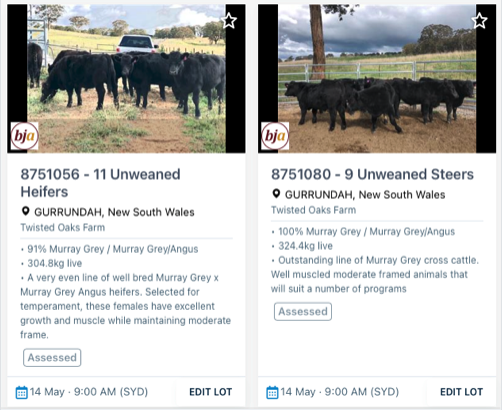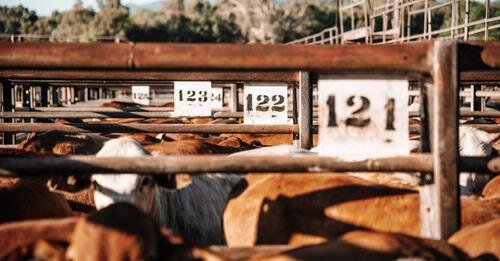The continued strength of the Australian cattle market is definitely the most frequent conversation starter among farmers and in the broader industry. For producers selling cattle, the record prices are exciting and have gone a long way to help recover from the costs of almost a decade of drought.
If you are purchasing cattle, however, the price of cattle can make you feel pretty concerned! The challenge of purchasing cattle on a rising market, with the hope the margin stays positive is something quite a lot of finishers, processors and even restocks are grappling with.
There are plenty of different market indicators that producers can look at as they watch the prices continue to set new records. The most frequently referred to is the Eastern Young Cattle Indicator or EYCI many people shorten it to. Tis week it set a new record of 1074c. The EYCI describes to seven-day rolling average of young cattle (vealer and yearling weight steer and heifer categories) from 23 saleyards across Queensland, NSW and Victoria. It is expressed in c/kg, carcase weight equivalent.
The Eastern Young Cattle Indicator
As a stock agent, I’ve been looking closely at the market over the last 12 months. And many people have suggested it must be an easy job with the prices being so strong.
I think its actually a tough time for new agents!
One of the things I have learnt, is when the pressure comes off production - either when the drought breaks or in this case, the market is so good, a lot of producers tend to relax their focus on the efficiencies that can make a big difference to their business.
During the drought, producers became very focussed on the cost of feeding. They considered how much animals required per day, the cost of energy and protein and the most effective methods of feeding and managing stock. Sadly when the season breaks and there isn’t the pressure to cost out daily rations, some people forget those lessons and inefficiencies tend to sneak back into the system.
Its much the same when it comes to selling stock. With the price of cattle almost double, how any people have actually stopped and looked at their costs of sale and considered if their marketing can be done better?
Its important you cattle’s attributes and value are understood and appreciated by your agent
A good example is a friend who sold 14 young heifers recently. They decided that this year they would keep with tradition and use their local agent, selling through a local auction. That’s fine and they made a good return. At the time about $1350 for their heifers.
In discussion I asked what did it cost to sell those cattle. Pulling out their sale records they added up the cost of transport to the sale years; the yard fees per head; the scanning fee charged at the yard; the national transaction levy and finally their agents commission. When they totalled the sum it came to $1375. So effectively the gave one of their 14 animals away in costs!
Now there is no escaping costs of sale. Commission is something agents charge to market the stock; arrange delivery; organise scanning; administer the movement and transaction levy. They also have to cover their costs in time t loo and try and sell the cattle for the best price. There is also the insurance they have to make sure you get paid for your cattle!
But, not all commissions are the same! So my first comment to all of my producers is to ask what do you receive for the commission that you pay?
Ideally your agent should be working to market your cattle to the best possible return. So that could be using their network to sell your cattle privately to someone seeking a particular article. It could be they will sell through auction on line or in the physical market. However, there’s more to just putting cattle into a sale or “on the box.”
In the case of AuctionsPlus, there can be thousands of cattle listed for sale. That does mean that your cattle are exposed to a much wider group of buyers than the local Saleyards. However, how will your agent make your cattle stand out? You should ask what their marketing plan is? What will they be doing to get your lots in front of the buyers?
AuctionsPlus is just one option to market your cattle
Its also important to make sure your agent understands the background of your cattle. What have you done to prepare them for the next owner? Are they part of a verification program? Accredited for MSA? Are they EU accredited or HGP free? Have they been preg tested and what genetics are they bred from?
Ultimately the last 3 or 4 years decisions and efforts are in the cattle you sell. So you need to ask the questions to make sure that your effort is being recognised.
One of the reasons I choose to take on an agents role was to offer my clients a choice.
Having been involved so closely in their bred decisions; the selection of their animals; preg testing and lifting fertility and helping navigate industry programs; I want to see the best results for that effort. I think its important to work to make sure those animals reach their full value.
Selling on behalf of my clients is a service, and in a year like this, that can be rewarding for everyone. I understand not every person will want to change their agent. I think that’s good. But, like every other aspect of your business, you need to sit done and check its actually the best direction and offering the best return for you.
Physical auctions can be a good method to market - but its not the only option!!
If it’s not, dont be afraid to question or to change direction to find the best option. After all, you have put a lot into the program and its important that be rewarded when you sell.
If you are keen to chat about how you can use my as an agent, or just to chat about options as you evaluate your program I’m really happy to have a chat, so I hope you feel comfortable getting in touch!




